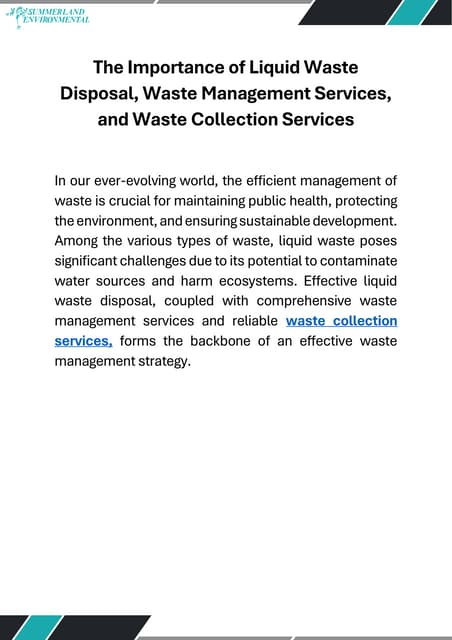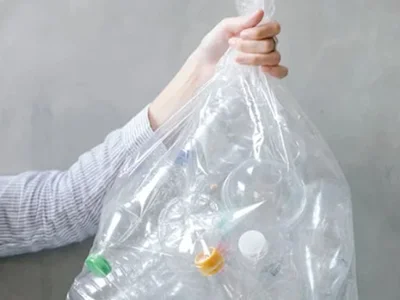Reclaim Waste for Beginners
Reclaim Waste for Beginners
Blog Article
A Biased View of Reclaim Waste
Table of ContentsReclaim Waste Can Be Fun For AnyoneThe Single Strategy To Use For Reclaim WasteThings about Reclaim WasteThe Single Strategy To Use For Reclaim WasteThe Definitive Guide for Reclaim WasteNot known Facts About Reclaim Waste

Never ever put unsafe compounds down sinks, commodes or stormwater drains Materials consisting of petrol, oil, oil, chemicals and herbicides, and solvents such as paint strippers should not be put down sinks, toilets or stormwater drains pipes. These compounds are tough to get rid of in the sewage therapy procedure and create air pollution troubles in our regional waterways.

Liquid waste is a term that covers a broad variety of products, there's an excellent factor why leaving its disposal to the professionals is recommended. Fluid waste is non-solid material that has no further use and needs to be treated and disposed of according to local, state and government regulations.
The Basic Principles Of Reclaim Waste
Although examples of fluid waste can consist of wastewater, fats, oils or grease, used oil, liquids, solids, gases or sludges and hazardous household liquids, there are some that are thought about to be extra unsafe than others when it comes to the environment and the health and wellness of pets and humans alike. It's because of this that each state and territory have stringent policies connected to liquid waste monitoring.
Fluid waste can be saved in holding storage tanks or packaged in drums, intermediate bulk containers or authorized small containers before either being dealt with or removed via outsourced vacuum vehicles. Offered the nature of the products, fluid waste can not go in the basic waste stream and there are rigorous policies on exactly how to deal with it correctly.
(https://www.intensedebate.com/people/reclaimwaste1)Depending upon a resolution of the level of threat, it might be needed to remediate those sites. In addition, hazardous fluid chemical wastes are controlled waste and must be tracked in conformity with the state waste regulations. Under the chain of wardship and responsibilities, owners are responsible and accountable for waste produced by a service.
One of the core applications for superabsorbent polymers (SAPs) is liquid waste solidification. industrial wastewater treatment. SAPs are made use of by waste monitoring experts to protect against potentially damaging liquids from going into rivers, groundwater aquifers, and other delicate environments. Because fluids can rapidly move impurities into environmental receptors and potentially add to geotechnical failings, fluid wastes are almost constantly forbidden from disposal in land fills
Some Known Facts About Reclaim Waste.
Primarily, free liquids are liquids that separate from the strong section of waste product. Fluid waste can consist of the following: HDD mud and cuttings Land fill leachate Wastewater treatment sludge & biosolids Dredged sediments Oil and gas drill cuttings Clearing up fish pond muck Hydro Excavation slurry Coal burning residuals/ash Container bottom sludge Concrete grinding/polishing slurry Relevant Short article: For a useful example of free fluids separating from waste material, consider the following scenario: A waste management professional loads a dump truck with sludge from a wastewater treatment plant's oygenation basin, during a regular maintenance event.
However, when the vehicle driver gets to the garbage dump, he notices water leaching from the sludge and pouring from the dump vehicle. The tons was turned down by the garbage dump and the chauffeur was required to throw away the waste as a liquid waste at a special facility, which boosted the disposal costs tremendously.
We also require to be liable for the correct disposal of our waste materials. It is not sufficient that we pay waste disposal firms to take care of our rubbish.
All about Reclaim Waste

Segregating your waste can start inside the home. Segregate dry and fluid waste as well as edible waste, biodegradable and non-biodegradable materials.
You can utilize old garbage container, container, garden pot or old plastic drums. Drill 4 to five holes in the container so the air can circulate. Layer the bottom with dirt to soak up the wet waste. Begin the composting procedure. Layer the compost with damp and completely dry waste along with soil to preserve an equilibrium between the wet and the dry.
The 7-Minute Rule for Reclaim Waste
Cover the compost container. As soon as a week, include soil on top of the compost. To assist in faster disintegration, you can also include semi composted soil to the garden compost. Preserve the compost. If you discover the odor is becoming too strong, include added papers and paper waste or add more holes to the compost bin to maintain the balance of the waste products.
We likewise require to be accountable for the correct disposal of our waste materials. It is not enough that we pay waste disposal business to take treatment of our rubbish.
Our waste, our responsibility. Have you ever questioned what takes place to your fluid waste after it's accumulated? Did you recognize that fluid waste can be reused?
The smart Trick of Reclaim Waste That Nobody is Discussing
Segregating your waste can begin inside the home. Segregate dry and liquid waste as well as edible waste, naturally degradable and non-biodegradable products.
You can use old garbage can, bucket, yard pot or old plastic drums. Drill 4 to 5 holes in the container so the air can flow. Layer all-time low with soil to soak up the wet waste. Beginning the composting process. Layer the garden compost with damp and dry waste as well as soil to preserve an equilibrium in between the damp and the completely dry.
To assist in faster decomposition, you can additionally add semi composted soil to the garden compost. If you see the smell is ending up being too strong, add added papers and paper waste or include even more holes to the compost container to maintain sites the balance of the waste products.
Report this page